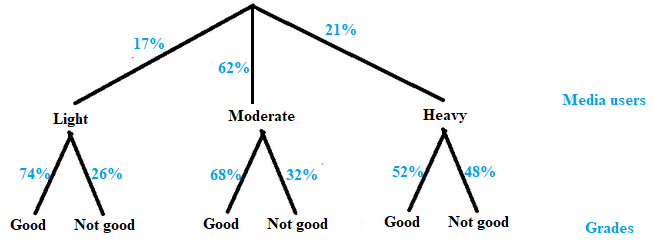
Concept explainers
(a)
Represent this chance process with Tree diagram.
(a)
Explanation of Solution
Given information:
Study about media influence in young people lives aged 8 − 18:
17% were classified as light media users
62% were classified as moderate media users
21% were classified as heavy media users
Respondents with good grades:
74% light users described their grades as good
68% moderate users described their grades as good
52% heavy users described their grades as good
First level:
First level consists of three types of media users:
Light, moderate and heavy
Thus,
The first level requires three children:
Light, moderate and heavy
Second level:
In this level, there are two types of grades:
Good grades or No Good grades
Thus,
The second level consists of two children per child at the first level i.e.; Good grades or No Good grades.
The required tree diagram can be drawn as:

(b)
(b)
Answer to Problem 82E
Probability for the person with good grades is 0.6566.
Explanation of Solution
Given information:
Study about media influence in young people lives aged 8 − 18:
17% were classified as light media users
62% were classified as moderate media users
21% were classified as heavy media users
Respondents with good grades:
74% light users described their grades as good
68% moderate users described their grades as good
52% heavy users described their grades as good
Calculations:
According to the general multiplication rule,
According to the
Let
L: Light user
M: Moderate user
H: Heavy user
G: Good grades
Gc: No Good grades
Now,
The corresponding probabilities:
Probability for light user,
Probability for moderate user,
Probability for heavy user,
Probability for light user with good grades,
Probability for moderate user with good grades,
Probability for heavy user with good grades,
Apply general multiplication rule:
Probability for user with good grades and light user,
Probability for user with good grades and moderate user,
Probability for user with good grades and heavy user,
Since each person cannot become more than one type of user.
Apply the addition rule for mutually exclusive events:
Thus,
Probability for the person describes his or her grades as good is 0.6566.
(c)
Conditional probability for the randomly chosen person describes his or her grade as good is a heavy user of media.
(c)
Answer to Problem 82E
Probability that the randomly chosen person describes his or her grade as good is a heavy user of media is approx. 0.1663.
Explanation of Solution
Given information:
Study about media influence in young people lives aged 8 − 18:
17% were classified as light media users
62% were classified as moderate media users
21% were classified as heavy media users
Respondents with good grades:
74% light users described their grades as good
68% moderate users described their grades as good
52% heavy users described their grades as good
Calculations:
According to the conditional probability,
From Part (b),
We have
Probability for the person describes his or her grades as good,
Probability for user with good grades and heavy user,
Apply the conditional probability:
Thus,
The probability for the person describes his or her grades as good is a heavy user of media is approx. 0.1663.
Chapter 5 Solutions
PRACTICE OF STATISTICS F/AP EXAM
Additional Math Textbook Solutions
An Introduction to Mathematical Statistics and Its Applications (6th Edition)
Essentials of Statistics (6th Edition)
Elementary Statistics: Picturing the World (6th Edition)
Elementary Statistics: Picturing the World (7th Edition)
Statistics: The Art and Science of Learning from Data (4th Edition)
 MATLAB: An Introduction with ApplicationsStatisticsISBN:9781119256830Author:Amos GilatPublisher:John Wiley & Sons Inc
MATLAB: An Introduction with ApplicationsStatisticsISBN:9781119256830Author:Amos GilatPublisher:John Wiley & Sons Inc Probability and Statistics for Engineering and th...StatisticsISBN:9781305251809Author:Jay L. DevorePublisher:Cengage Learning
Probability and Statistics for Engineering and th...StatisticsISBN:9781305251809Author:Jay L. DevorePublisher:Cengage Learning Statistics for The Behavioral Sciences (MindTap C...StatisticsISBN:9781305504912Author:Frederick J Gravetter, Larry B. WallnauPublisher:Cengage Learning
Statistics for The Behavioral Sciences (MindTap C...StatisticsISBN:9781305504912Author:Frederick J Gravetter, Larry B. WallnauPublisher:Cengage Learning Elementary Statistics: Picturing the World (7th E...StatisticsISBN:9780134683416Author:Ron Larson, Betsy FarberPublisher:PEARSON
Elementary Statistics: Picturing the World (7th E...StatisticsISBN:9780134683416Author:Ron Larson, Betsy FarberPublisher:PEARSON The Basic Practice of StatisticsStatisticsISBN:9781319042578Author:David S. Moore, William I. Notz, Michael A. FlignerPublisher:W. H. Freeman
The Basic Practice of StatisticsStatisticsISBN:9781319042578Author:David S. Moore, William I. Notz, Michael A. FlignerPublisher:W. H. Freeman Introduction to the Practice of StatisticsStatisticsISBN:9781319013387Author:David S. Moore, George P. McCabe, Bruce A. CraigPublisher:W. H. Freeman
Introduction to the Practice of StatisticsStatisticsISBN:9781319013387Author:David S. Moore, George P. McCabe, Bruce A. CraigPublisher:W. H. Freeman





